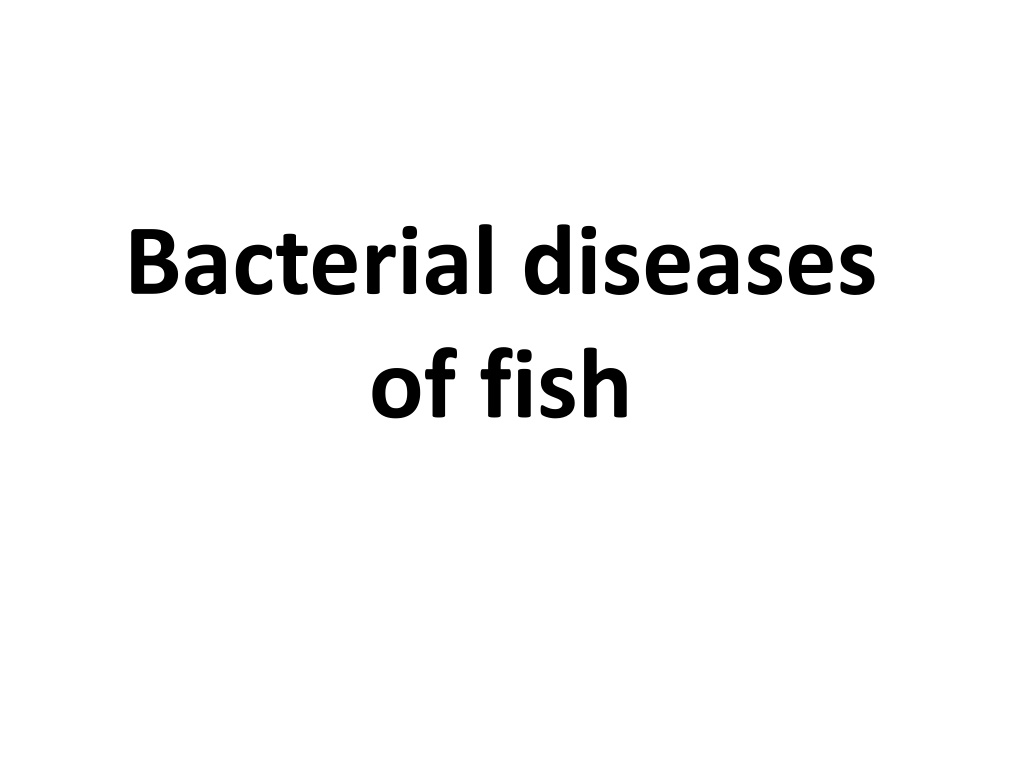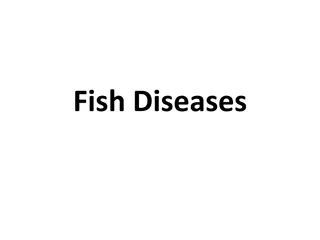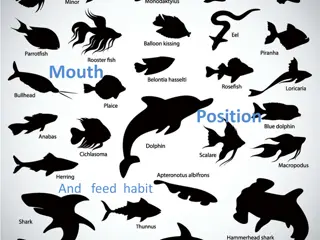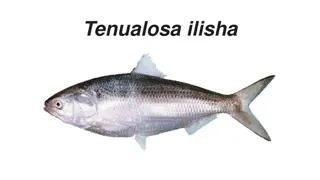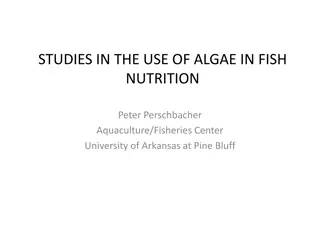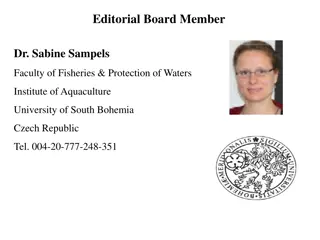Understanding Bacterial Diseases of Fish
Bacterial diseases such as Haemorrhagic Septicemia can affect fish, causing symptoms like haemorrhaging, skin ulcers, and abdominal haemorrhages. These diseases are often linked to environmental factors like overcrowding, pollution, and warm water temperatures, and can lead to significant mortalities in fish populations.
Download Presentation

Please find below an Image/Link to download the presentation.
The content on the website is provided AS IS for your information and personal use only. It may not be sold, licensed, or shared on other websites without obtaining consent from the author. Download presentation by click this link. If you encounter any issues during the download, it is possible that the publisher has removed the file from their server.
E N D
Presentation Transcript
Bacterial diseases of fish
Bacterial Haemorrhagic Septicemia (Infectious abdominal dropsy, motile aeromonad disease, Redmouth disease) Many authors have identified fish species that are susceptible to all types and strains of motile aeromonads, but it is quite likely that most septicaemic forms of diseases in cyprinids are the result of aeromonad infection. For example in cyprinids, the familiar ulcerative disease in carp and goldfish may be caused by Aeromonas.salmonicida sub sp. achromogenes. In Europe, infection by this group of bacteria in cyprinids is widely known as summer ulcer disease .
Clinical pathology and diagnosis These organisms can be responsible for septicaemia disease in cyprinids, and the changes include haemorrhaging and surface ulcers of the skin, protruding scales, scale loss, exophthalmia, abdominal haemorrhages on the gills. Internal examination may reveal varying amounts of pinkish-red fluid liberated from the abdomen when the fish is incised. Frequently there are haemorrhages and reddening of the gastro-intestinal tract, enlargement of the spleen and mottling of the liver swelling and petechial .
In histological sections, the lesion site reveals a loss of the epidermal epithelium, with inflammation and necrosis extending through the dermis and in some cases into the musculature. When the muscle tissue is affected, it becomes haemorrhagic and liquefied and colonies of bacteria can usually be seen in histological sections .
Occurrence Bacterial frequently environmental overcrowding, pollution, low oxygen levels and raised water temperatures. In fact, any combination of the septicaemic disease in temperate cyprinids. Handling stress, warm weather and raised water temperatures common predisposing factors in epizootics associated with many bacterial diseases in septicaemia associated conditions in cyprinids with such is poor as above can lead to (above 12 C) are cyprinids.
Mortalities are generally low, perhaps up to 25%, but this figure depends on the population density and water conditions. Injuries, such as predators or angling, cause wounds that are ideal for aeromonad infections. those caused by
In terms of geographical distribution, diseases caused by motile aeromonads are found in both farmed and wild cyprinids, worldwide.
Prevention and treatment Prevention of aeromonad diseases, like the majority of bacterial cyprinid populations, because of the movements of fish that take place for the ornamental industry and for sport fishing and aquaculture purposes. diseases made amount in is difficult huge of
Treatments can be administered either prophylactic control or chemotherapeutic measure, however, antibiotic sensitivity tests must be performed before any antibiotics are administered.
Bacteria Gill Disease This disease affects mainly young fish of all species, but it is not uncommon in growers and even broodstock. The disease can occur throughout the year, but outbreaks are more common in spring than in late summer and fall.
Aetiology Flavobacterium branchiophila, is a Gram- negative, long, thin, filamentous rod
Clinical signs of disease Gill is the only target organ and clinical signs include lethargy, dyspnea, coughing and flared opercula. Strands of mucus may trail from the gills and gill themselves may exhibit pale and/or swollen areas. Large numbers of diseased fish gather near the screen or inlet of the pond. Acute epizootics may result in a 20 to 50% mortality in 24 h.
Diagnosis Clinical signs, wet gill smears or histopathology. Isolation on Cytophaga Agar at 18 C.
Source Carrier fish or contaminated water are considered to be sources of infection. However, epizootics are almost always associated with a environmental conditions. deterioration of
Prevention Maintenance of a high quality environment is of utmost importance in the prevention of bacterial gill disease. Population level should be kept at lowest feasible levels to reduce the effects of crowding. The application of good sanitation practices is important. Clean ponds provided with an adequate flow of clean water coupled with prompt removal of dead or weak fish will reduce incidence of the disease.
Treatment BGD usually responds well to antiseptic and surfactant baths such as Chloramine-T used in a single treatment at 10 ppm in a one-hour flush treatment but its effectiveness and toxicity are greatly affected by water quality chlorides are used in concentrations of 1 - 2 ppm (calculated on the basis of the active ingredient) as a I-h bath or continuous flow treatment and Diquat it has been used at a concentration of 8.4 - 16.8 ppm of the formulated material, or 2 - 4 ppm on the basis of active ingredient (Diquat cation). Providing adequate oxygen is useful supportive therapy. Most compounds require multiple applications for effective and benzalkonium results.
Salmon fry affected by bacterial gill disease and presenting with mottled and swollen gills.
